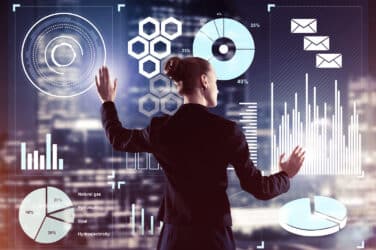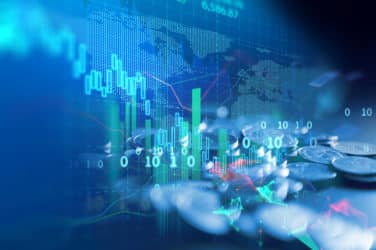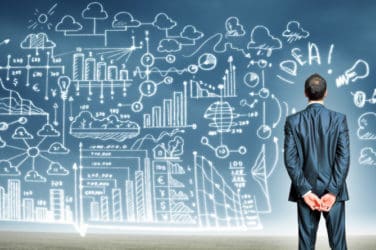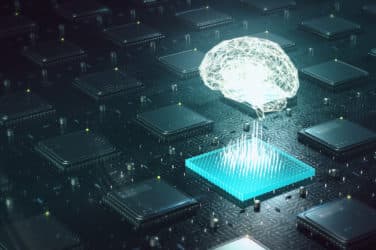Wall Street and the Centaur: Human + A.I.
By David M. Aferiat, Co-Founder and Managing partner, TradeIdeas LLC
“On this – to have a satisfying understanding of the brain — I think we’re a century away.” Eric Kandel, Nobel Laureate Physiology and Medicine[1] Winter 2016
“The democratization of information has made it much harder for active management…. We have to change the ecosystem — that means relying more on big data, artificial intelligence, factors and models within quant and traditional investment strategies.”[2] Laurence Fink Chairman and CEO BlackRock, Inc. March 2017
“The report of my death was an exaggeration.”[3] Mark Twain
AI and Learning Machines: Wall Street’s Latest Tools

David Aferiat, TradeIdeas
So will the machines take over Wall Street? Yes and no. From Baron Reuters’ pigeons to the telegraph, ticker, and telephone, to the ECNs, Wall Street has consistently adopted tools to leverage information asymmetries and develop strategies to generate alpha. That Wall Street has increasingly turned to big data, A.I. and machine learning as the latest iteration in this evolution comes as no surprise – Wall Street, like other industries, transforms as new tools become available.
What is surprising is the notion that somehow the tools will be so good at developing strategies and reducing risk, that no human intelligence (or curiosity or questions – or any higher brain functions) will be necessary moving forward. That previous technological developments replaced the need for as many people on Wall Street (think punch card operators of the 1960s), did not mean that machines will ever displaced the human in the equation.
The whole “replace” conversation occurs in part because people are good at metaphors, even if the metaphors are merely approximate. So, humans develop computers, look at the brain and make the leap that brain is a computer. Close, but no cigar. When systems theory was developed the brain was a system. Again, close but no cigar. The fact is the brain is a brain – a little understood and highly complex organ that has developed and used tools that have changed how people go about their lives, but not once has a tool fully replaced the need for people. Because we are both shrewd and smart (or at least not so stupid) as to let a machine go that far – Kubrick’s HAL from 2001: A Space Odyssey notwithstanding.
On Wall Street Humans and Artificial Intelligence are taking the next step together – not pitted against one another.
I recently joined a group in Atlanta to listen to Kevin Kelly, a founder and founding editor of Wired magazine who David Pogue (Yahoo Tech) described as a futurist holding “a crystal ball, only without the risk of shattering.” He’s written a new book called, The Inevitable[4], that describes the technology landscape we’re headed towards. He argues it’s hard to predict specific product and service innovations such as an iPhone, but like rain on a mountaintop, technology “leans” and flows in a certain direction that we can anticipate and from which we can innovate.
Much of Kelly’s conversation about artificial intelligence and its growing impact on our lives is the open door through which the team assembled at Trade Ideas, my firm, is running.
To get down to cases, how is Kelly’s analysis impacting Wall Street?
Enter The Centaur
The arrival of A.I. in our lives is the congruence of three developments: Cheap parallel computing; Big Data; and Better Algorithms. A decade ago it was within the realm of possible to navigate the markets manually applying indicators like RSI, Elliott Wave or Bollinger Bands to charts and to make a decision. Those days are gone. Today’s markets demand an enormous amount of analysis across a much larger range of variables. That’s possible with the plentiful capacity of computational power available and the next wave in Big Data which I refer to as Big Data 2.0.
The first wave of Big Data showcased the insight gained from vast quantities of analysis and information. The second wave of Big Data is the automation of actions based on such perspective and insight. Among our strongest competencies at Trade Ideas’ is this ability to turn Big Data into actionable market intelligence. That’s in part because the market provides a real-time avalanche of data spanning decades necessary to feed an A.I. engine and teach it to produce daily ideas with the highest statistical probability of profitability.
Finally there’s the pursuit of the better algorithm. In 1997 IBM’s Deep Blue (predecessor to Watson) beat the reigning chess grand master Garry Kasparov. After his defeat Kasparov realized that he would have performed better had he access to the same database of all previous chess moves. This led to the creation of “freestyle” chess matches where today the option exists for A.I. to assist humans against other such teams or A.I. alone. Kasparov coined the term Centaur to describe when A.I. augments human behavior.
The algorithms produced by Trade Ideas’ A.I. are tested and optimized from “base” strategies designed by our technicians. Our customers receive the stream of A.I. ideas with specific trading plans that they then decide to follow, modify, or extend beyond hold times. The kind of A.I. needed for robotic surgery is still not ready for primetime yet, but Centaurs like HOLLY and our customers are examples of a combination of human, oceans of data, and A.I. connected to achieve more that’s here today.
It is worthwhile to mention that even Kelly was subject to tech breakdown and had to rely on his brain for his presentation. A last minute glitch in technology prevented the audience from seeing his slides! Take A/V equipment, add A.I., and get the auto-tuning, self-adjusting presenter? Not likely.
So Now What?
It is no great insight that people use tools. And that people adapt and are displaced as new tools come into use.
Yet, like Twain, the end of humans on Wall Street is an exaggeration. And like Kandel, the brain is barely understood at this point. But as Fink so aptly articulates – the new A.I. and machine learning tools are here to stay. They will improve and new opportunities will arise as they are deployed.
The half-horse, half human Centaur of classical mythology was a liminal being – caught between the two natures. On the one hand centaurs embodied the myth of untamed nature (read the perennial Wall Street saw of fear and greed) and as teachers on the other (read the pure rationality of A.I.)
Because at its heart Wall Street is a global human enterprise subject to an organic flow of information and emotion, driven by risk, sentiment, and global events. All of which A.I digests and informs but can never determine or decide on a specific course of action or response.
[1] Columbia Magazine Winter 2016 http://magazine.columbia.edu/features/winter-2016/your-beautiful-brain?page=0,5
[2] https://www.nytimes.com/2017/03/28/business/dealbook/blackrock-actively-managed-funds-computer-models.html?_r=0
[3] https://www.google.com/search?q=the+report+of+my+deathg+wqas+an+exaggeration&oq=the+report+of+my+deathg+wqas+an+exaggeration&aqs=chrome..69i57j0l5.11291j0j4&sourceid=chrome&ie=UTF-8
[4] Kelly, Kevin. The Inevitable: Viking, 2016






